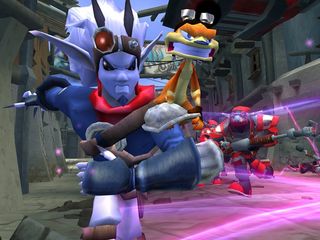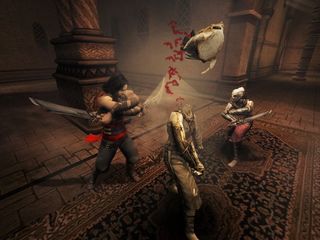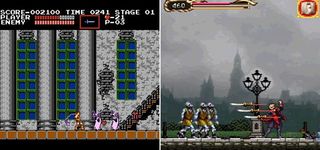Well, that’s often true. And yes, the industry is full of stories of publishers killing a promising new property so they can milk a proven franchise for more games. But it’s an argument that completely ignores the ability of some sequels to completely shake things up and change the “safe” formula a franchise had previously established. Some of these did well enough to set the template their series would follow in the future; others failed to catch on and faded to black-sheep status. Boom or bust, here are seven of the most drastic examples we could think of:
What it was before: A colorful, Banjo Kazooie-inspired platformer about a mute elf-boy and his mouthy ottsel sidekick. While it had some sci-fi elements, it had a relatively bright tone that was much closer to fantasy, as the pair wandered through a big, seamless world punching out goofy monsters and hunting for assorted collectible knickknacks.

What it became: A weird sci-fi take on Grand Theft Auto. Beginning by flinging its protagonists centuries into the future, Jak II twisted its formerly pure-hearted hero into a growling, goateed asshole who ran errands for crime lords, gunned down red-armored cops and could turn into a hulking were-beast. While a lot of the platforming-gameplay elements remained the same, the action was moved to a big, open, dystopian hub city in which Jak could steal flying cars at will, and third-person shooting – which hadn’t been part of the first game at all – suddenly became a key part of the action.

What kept this from being terrible was that, in spite of its darker tone, Jak II still didn’t take itself too seriously. A lot of the first game’s cartoonish appeal and overt goofiness was preserved, and Jak’s brooding new personality turned out to be a phase. Also, while the shift in tone turned off some of the first game’s fans, the changes added a lot to what was already a stellar platformer. But it’s hard to think of a series that underwent a more drastic shift in tone between the first and second games than Jak & Daxter.

Above: Except for maybe this one
Where it went from there: First into the deep desert, as Jak 3 dropped some of Jak II’s GTA-ishness for a Mad Max-esque, barbarian-scavenger adventure. Then it shifted to dedicated kart racing with the spinoff Jak X (following the same three-games-then-a-kart-racer pattern developer Naughty Dog set with Crash Bandicoot), before returning to platforming with the scaled-down Daxter on PSP. Finally, its platforming was melded with air piracy in the so-so Jak and Daxter: The Lost Frontier. While most of the gameplay elements introduced by Jak II have remained, though, the series has never bared its teeth quite as menacingly as it did when Jak spoke his first words:
What it was before: A linear, arcade-style platformer/action game about whipping monsters to death and getting knocked into bottomless pits by medusa heads.

What it became: While the basic Castlevania gameplay remained the same in Simon’s Quest – jump around on platforms, whip monsters – the structure was radically altered. Gone were the convenient levels with their predictable monsters and singular sub-weapons, and in their place was a huge, open-ish side-scrolling world of towns, forests, lakes and mansions. The first game’s linearity was a thing of the past, too, replaced by a quest to track down and recover Dracula’s body parts so that Simon Belmont could resurrect him, lift his death curse and then kill him again. Roll in new abilities, persistent weapons and power-ups for Simon that could be purchased or earned, and the foundations were set for what would later be called the Metroidvania genre.

Where it went from there: Right back to where it started. Castlevania III, IV, Bloodlines and Rondo of Blood/XX/Vampire’s Kiss were all linear monster-stomps in the mold of the first game, as were all the Game Boy Castlevanias. For years, it looked like Simon’s Quest was doomed to be the black sheep of the family, forever standing out like a failed experiment.
Then, in 1997, Castlevania: Symphony of the Night rolled out onto the PlayStation, introducing an exploration-heavy, Metroid-style structure that hugely expanded on the elements introduced in Simon’s Quest (and actually inspired the term “Metroidvania”). This time, the design changeswere here to stay; of the 17 Castlevania games that followed Symphony’s release, 12 of them either mimicked its free-exploration formula exactly, or at least featured some variation on it.

Above: And all because of one horrible night to have a curse
The release of Lords of Shadow might change all that, though; while it features some of the puzzle-solving, RPG elements and hidden areas that make the Symphony-style games interesting, it’s still a linear, level-based game. It also plays more like a God of War than a Castlevania, though, so whether it’ll actually redirect the series from here on out remains to be seen.

